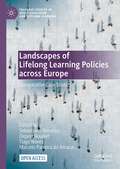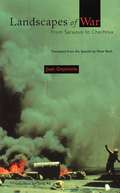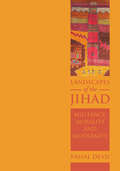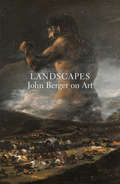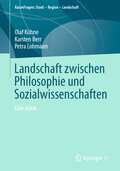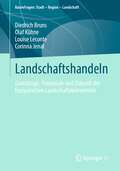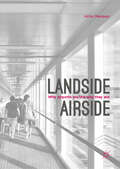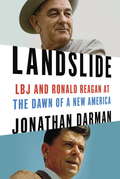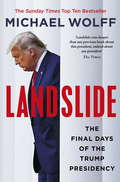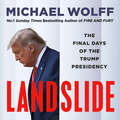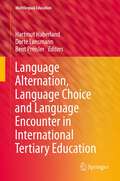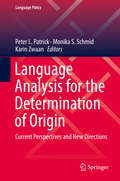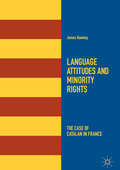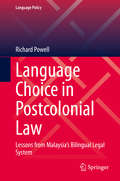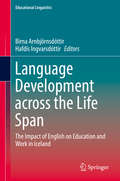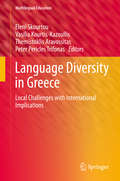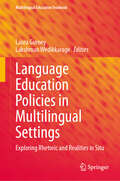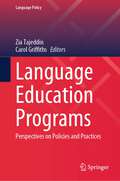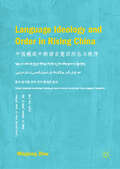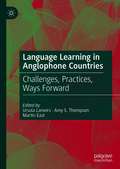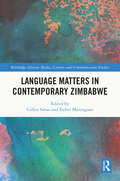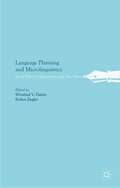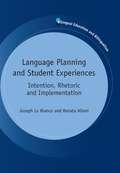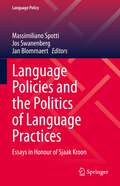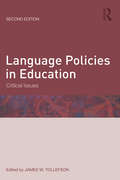- Table View
- List View
Landscapes of Lifelong Learning Policies across Europe: Comparative Case Studies (Palgrave Studies in Adult Education and Lifelong Learning)
by Marcelo Parreira do Amaral Sebastiano Benasso Dejana Bouillet Tiago NevesThis open access book explores different landscapes of Lifelong Learning policies (LLP), producing case-based examinations of their institutional, discursive, and relational dimensions. Across Europe, young people develop their life courses amidst diverse living conditions and are confronted with a variety of institutional and structural arrangements that impact on their opportunities in education and labour. Considering the relevance of LLP in shaping those opportunities, the chapters draw from multi-level, mixed-methods research and offer original insights on the interplay of discourses and governance patterns in the processes of policy-making and deliverance. The book yields noteworthy insights into the widely differing realities across the European landscape, and also into the diverging ways young people deal with and actively participate in LLP.
Landscapes of War: From Sarajevo to Chechnya
by Juan Goytisolo Peter BushAn incisive examination of the tensions that exist between the West and Islamic societies of Europe, North Africa, and the Middle East. Provides rich historical analysis and reportage of life in four explosive war-zones: Sarajevo, Algeria, the West Bank and Gaza, and Chechnya. Translated by Peter Bush.
Landscapes of the JIHAD: Militancy, Morality, Modernity
by Faisal DevjiWhat are the motives behind Osama bin Laden's and Al-Qaeda's jihad against America and the West? Innumerable attempts have been made in recent years to explain that mysterious worldview. In Landscapes of the Jihad, Faisal Devji focuses on the ethical content of this jihad as opposed to its purported political intent. Al-Qaeda differs radically from such groups as Egypt's Muslim Brotherhood and Indonesia's Jemaah Islamiyah, which aim to establish fundamentalist Islamic states. In fact, Devji contends, Al-Qaeda, with its decentralized structure and emphasis on moral rather than political action, actually has more in common with multinational corporations, antiglobalization activists, and environmentalist and social justice organizations. Bin Laden and his lieutenants view their cause as a response to the oppressive conditions faced by the Muslim world rather than an Islamist attempt to build states.Al-Qaeda culls diverse symbols and fragments from Islam's past in order to legitimize its global war against the "metaphysical evil" emanating from the West. The most salient example of this assemblage, Devji argues, is the concept of jihad itself, which Al-Qaeda defines as an "individual duty" incumbent on all Muslims, like prayer. Although medieval Islamic thought provides precedent for this interpretation, Al-Qaeda has deftly separated the stipulation from its institutional moorings and turned jihad into a weapon of spiritual conflict. Al-Qaeda and its jihad, Devji suggests, are only the most visible manifestations of wider changes in the Muslim world. Such changes include the fragmentation of traditional as well as fundamentalist forms of authority. In the author's view, Al-Qaeda represents a new way of organizing Muslim belief and practice within a global landscape and does not require ideological or institutional unity. Offering a compelling explanation for the central purpose of Al-Qaeda's jihad against the West, the meaning of its strategies and tactics, and its moral and aesthetic dimensions, Landscapes of the Jihad is at once a sophisticated work of historical and cultural analysis and an invaluable guide to the world's most prominent terrorist movement.
Landscapes: John Berger on Art
by John BergerA major new work from the world's leading writer on artAs leading radical writer on art John Berger celebrates his ninetieth year, he brings a lifetime's engagement with the ideas, artists, and thinkers that have shaped his thinking: Walter Benjamin, Rosa Luxemburg and Bertolt Brecht among them. In Landscapes Berger allows us to see the evolution of his own way of seeing. He explores the relationship between creativity and politics and the revolutionary potential of art through a series of different forms.As always, in this book, Berger pushes at the limits of art writing, demonstrating beautifully how his painter's eyes lead him to refer to himself only as a storyteller. A landscape is, to John Berger, like a portrait, an animating, liberating metaphor rather than a rigid definition. Landscapes offers a tour of the history of art, but not as you know it.Landscapes brings together Berger's most penetrating insights into how we may engage with both art and the artist in society.From the Hardcover edition.
Landschaft zwischen Philosophie und Sozialwissenschaften: Eine Kritik (RaumFragen: Stadt – Region – Landschaft)
by Olaf Kühne Karsten Berr Petra LohmannDie Befassung mit ‚Landschaft‘ hat in den letzten Jahren in der Öffentlichkeit und den Wissenschaften an Bedeutung gewonnen. Verbunden war dies nicht vorwiegend mit den Konflikten, die sich in den letzten Jahren um physische Manifestationen der Verminderung von und Anpassung an den anthropogenen Klimawandel ergaben. In Philosophie und Sozialwissenschaften haben sich – nicht zuletzt ausgehend von einem gemeinsamen Bezugspunkt der ‚Philosophie der Landschaft‘ von Georg Simmel aus dem Jahre 1913 – unterschiedliche Traditionen im Umgang mit ‚Landschaft‘ entwickelt. Diese werden in dem vorliegenden Buch hinsichtlich ihrer Tauglichkeit einer Kritik unterzogen, Antworten auf die landschaftsbezogenen Herausforderungen der Gegenwart, sowohl in Bezug auf Wissenschaft, aber auch Gesellschaft zu leisten. Diese Kritik basiert auf einem eigens hierfür entwickelten kategorialen System, das sich zwischen den Dimensionen Konkretheit-Abstraktheit und wissenschaftsintern-wissenschaftsextern aufspannt. Zentrale herausgearbeitete Kritikpunkte sind neben einer unzureichenden Begriffsarbeit und einer ‚Individuenvergessenheit‘ beider Disziplinen auch die Reduzierung des Landschaftsbegriffs auf den Naturbegriff in der philosophischen Landschaftsforschung.
Landschaftshandeln: Grundzüge, Potenziale und Zukunft der Europäischen Landschaftskonvention (RaumFragen: Stadt – Region – Landschaft)
by Olaf Kühne Corinna Jenal Diedrich Bruns Louise LeconteDie von 40 Staaten unterzeichnete und 2004 in Kraft getretene Europäische Landschaftskonvention stellt ein zentrales Dokument der Befassung mit Landschaft dar. Es basiert in großen Teilen auf einer konstruktivistischen Vorstellung von Landschaft und stellt Menschen bei Erhaltung und Entwicklung von Landschaft in den Mittelpunkt. In diesem Buch befassen sich namhafte Autor*innen mit Fragen der rechtlichen, sozialen, politischen und planerischen Bedeutung der Konvention. Neben Fallbeispielen der Umsetzung in verschiedenen europäischen Ländern geht es auch um die Frage, warum Deutschland mit der Unterzeichnung der ELK zögert und wie sich eine Umsetzung in Deutschland gestalten könnte.
Landside | Airside: Why Airports Are the Way They Are
by Victor MarquezWhy do we love and hate airports at the same time? Have you been a victim of tiresome walks, congestion, long lines, invasive pat-downs, eternal delays and so on? Perhaps no other technological system has been challenged by continuously changing paradigms like airports. Think a minute on rail stations; think of how successful are the rail networks of the world in connecting nations, with just minimum security measures. Why aviation and airports are so radically different in this regard?In order to answer those questions the author embarks on a thorough revision of airport history and airport planning that in the end builds up a new theory about how airports are formed from the outset. Within its journey from the early airfield to the newest hubs of today, Dr. Marquez identifies for the first time the Landside–Airside boundary as the single most important feature that shapes an airport. In this sense, his finding challenges the “historical linearity” that, until today, used to explain a century of airports.From both an analytical and theoretical S&TS stance, Dr. Marquez assures that it is only when airports needed to be fully reinvented (LaGuardia, Dulles and Tampa) when they become transparent and we may be able to understand their lack of technological stability.
Landslide
by Jonathan DarmanIn politics, the man who takes the highest spot after a landslide is not standing on solid ground. In this riveting work of narrative nonfiction, Jonathan Darman tells the story of two giants of American politics, Lyndon Johnson and Ronald Reagan, and shows how, from 1963 to 1966, these two men--the same age, and driven by the same heroic ambitions--changed American politics forever. The liberal and the conservative. The deal-making arm twister and the cool communicator. The Texas rancher and the Hollywood star. Opposites in politics and style, Johnson and Reagan shared a defining impulse: to set forth a grand story of America, a story in which he could be the hero. In the tumultuous days after the Kennedy assassination, Johnson and Reagan each, in turn, seized the chance to offer the country a new vision for the future. Bringing to life their vivid personalities and the anxious mood of America in a radically transformative time, Darman shows how, in promising the impossible, Johnson and Reagan jointly dismantled the long American tradition of consensus politics and ushered in a new era of fracture. History comes to life in Darman's vivid, fly-on-the wall storytelling. Even as Johnson publicly revels in his triumphs, we see him grow obsessed with dark forces he believes are out to destroy him, while his wife, Lady Bird, urges her husband to put aside his paranoia and see the world as it really is. And as the war in Vietnam threatens to overtake his presidency, we witness Johnson desperately struggling to compensate with ever more extravagant promises for his Great Society. On the other side of the country, Ronald Reagan, a fading actor years removed from his Hollywood glory, gradually turns toward a new career in California politics. We watch him delivering speeches to crowds who are desperate for a new leader. And we see him wielding his well-honed instinct for timing, waiting for Johnson's majestic promises to prove empty before he steps back into the spotlight, on his long journey toward the presidency. From Johnson's election in 1964, the greatest popular-vote landslide in American history, to the pivotal 1966 midterms, when Reagan burst forth onto the national stage, Landslide brings alive a country transformed--by riots, protests, the rise of television, the shattering of consensus--and the two towering personalities whose choices in those moments would reverberate through the country for decades to come. Advance praise for Landslide "Jonathan Darman turns fresh eyes on two political giants of the late twentieth century, LBJ and Ronald Reagan. Landslide is full of surprises and new insights on these two presidents, and is written with flair. A delicious feast of a read."--Lesley Stahl"Masterly . . . In taking us back to a moment in American history when politics worked, Jonathan Darman provides a resonant reality check on a system that now seems all too dysfunctional. The intertwined stories of Lyndon Johnson and Ronald Reagan offer us a window on the intrinsic give-and-take that makes governing possible. Anyone who cares about politics, biography, and current affairs will find this a delightful and illuminating book."--Jon Meacham, author of Thomas Jefferson: The Art of Power "Jonathan Darman writes with power, sweep, vivacity, and humor. He is at once a gifted storyteller, a keen judge of character, and a genie of political insight. He gives us two giants, Lyndon Johnson and Ronald Reagan, in all their glory and human vanity, and takes us on a breathtaking thousand-day ride."--Evan Thomas, author of Ike's Bluff and The Wise MenFrom the Hardcover edition.
Landslide: The Final Days of the Trump Presidency
by Michael WolffTHE INSTANT SUNDAY TIMES BESTSELLER 'Landslide cuts deeper than any previous book about this president, indeed about any president' The Times'First there was Fire and Fury, then there was Siege, now there is Landslide. The third is the best of the three . . . Required reading' Guardian'Michael Wolff concludes his Trump trilogy - with the best book yet . . . Unforgettable' Telegraph'Wolff is the shrewdest chronicler of Trump' Sunday Times__________________________________________'We won. Won in a landslide. This was a landslide.'President Donald J. Trump, 6 January 2021Politics has given us some shocking and confounding moments but none have come close to the careening final days of Donald Trump's presidency: the surreal stage management of his re-election campaign, his audacious election challenge, the harrowing mayhem of the storming of the Capitol and the buffoonery of the second impeachment trial. But what was really going on in the inner sanctum of the White House during these calamitous events? What did the president and his dwindling cadre of loyalists actually believe? And what were they planning?Drawing on an exclusive and wide range of sources who took part in or witnessed Trump's closing moments, Michael Wolff finds the Oval Office more chaotic and bizarre than ever before, a kind of Star Wars bar scene. At all times of the day, Trump, hunched behind the Resolute desk, is surrounded by schemers and unqualified sycophants who spoon-feed him the 'alternative facts' he hungers to hear - about COVID-19, Black Lives Matter protests, and, most of all, his chance of winning re-election. In this extraordinary telling of a unique moment in history, Wolff gives us front row seats as Trump's circle of plotters whittles down to the most enabling and the least qualified - and the president overreaches the bounds of democracy, entertaining the idea of martial law and balking at calling off the insurrectionist mob that threatens the hallowed seat of democracy itself.Michael Wolff pulled back the curtain on the Trump presidency with his globally bestselling blockbuster Fire and Fury. Now, in Landslide, he closes the door on the presidency with a final, astonishingly candid tale.
Landslide: The Final Days of the Trump Presidency
by Michael WolffIncludes an introduction read by Michael Wolff, as well as archival recordings of speeches made by Rudy Giuliani, Sidney Powell, and Donald Trump.'We won. Won in a landslide. This was a landslide.'President Donald J. Trump, 6 January 2021Politics has given us some shocking and confounding moments but none have come close to the careening final days of Donald Trump's presidency: the surreal stage management of his re-election campaign, his audacious election challenge, the harrowing mayhem of the storming of the Capitol and the buffoonery of the second impeachment trial. But what was really going on in the inner sanctum of the White House during these calamitous events? What did the president and his dwindling cadre of loyalists actually believe? And what were they planning?Drawing on an exclusive and wide range of sources who took part in or witnessed Trump's closing moments, Michael Wolff finds the Oval Office more chaotic and bizarre than ever before, a kind of Star Wars bar scene. At all times of the day, Trump, hunched behind the Resolute desk, is surrounded by schemers and unqualified sycophants who spoon-feed him the 'alternative facts' he hungers to hear - about COVID-19, Black Lives Matter protests, and, most of all, his chance of winning re-election.In this extraordinary telling of a unique moment in history, Wolff gives us front row seats as Trump's circle of plotters whittles down to the most enabling and the least qualified - and the president overreaches the bounds of democracy, entertaining the idea of martial law and balking at calling off the insurrectionist mob that threatens the hallowed seat of democracy itself.Michael Wolff pulled back the curtain on the Trump presidency with his globally bestselling blockbuster Fire and Fury. Now, in Landslide, he closes the door on the presidency with a final, astonishingly candid tale.
Language Alternation, Language Choice and Language Encounter in International Tertiary Education
by Bent Preisler Dorte Lønsmann Hartmut HaberlandReflecting the increased use of English as lingua franca in today's university education, this volume maps the interplay and competition between English and other tongues in a learning community that in practice is not only bilingual but multilingual. The volume includes case studies from Japan, Australia, South Africa, Germany, Catalonia, China, Denmark and Sweden, analysing a range of issues such as the conflict between the students' native languages and English, the reality of parallel teaching in English as well as in the local language, and classrooms that are nominally English-speaking but multilingual in practice. The book assesses the factors common to successful bilingual learners, and provides university administrators, policy makers and teachers around the world with a much-needed commentary on the challenges they face in increasingly multilingual surroundings characterized by a heterogeneous student population. Patterns of language alternation and choice have become increasingly important to the development of an understanding of the internationalisation of higher education that is occurring world-wide. This volume draws on the extensive and varied literature related to the sociolinguistics of globalisation - linguistic ethnography, discourse analysis, language teaching, language and identity, and language planning - as the theoretical bases for the description of the nature of these emerging multilingual communities that are increasingly found in international education. It uses observational data from eleven studies that take into account the macro (societal), meso (university) and micro (participant) levels of language interaction to explicate the range of language encounters - highlighting both successful and problematic interactions and their related language ideologies. Although English is the common lingua franca, the studies in the volume highlight the importance of the multilingual resources available to participants in higher educational institutions that are used to negotiate and solve their language problems. The volume brings to our attention a range of important insights into language issues found in the internationalisation of higher education, and provides a resource for those wishing to understand or do research on how language hybridity and multilingual communicative practices are evolving there. Richard B. Baldauf Jr., Professor, The University of Queensland
Language Analysis for the Determination of Origin: Current Perspectives And New Directions (Language Policy #16)
by Monika S. Schmid Peter L. Patrick Karin ZwaanThis comprehensive, up-to-date volume reports on current practices and use of Language Analysis for the Determination of Origin (LADO). Readers will find chapters on how it is done, where it is used, how it is used, and learn about recent developments on the use of LADO reports in judicial practice, and current controversies in the field. LADO is a highly controversial topic, and a relatively new branch of forensic linguistics that is used by most European and some non-European governments. When asylum seekers cannot submit documentary proof of their origin, their language can be analysed in order to assess whether their linguistic profile is in accordance with their stated origin. Around 10,000 such language analyses take place annually. This volume is based on the series of meetings of the Language and Asylum Research Group held between 2010 and 2012 and convened by the editors, and offers a state-of-the art perspective from researchers, practitioners, policymakers and stakeholders working on or with LADO.
Language Attitudes and Minority Rights: The Case Of Catalan In France
by James HawkeyThis book presents a detailed sociolinguistic study of the traditionally Catalan-speaking areas of Southern France, and sheds new light on language attitudes, phonetic variation, language ideologies and minority language rights. The region’s complex dual identity, both Catalan and French, both peripheral and strategic, is shown to be reflected in the book’s attitudinal findings which in turn act as reliable predictors of phonetic variation. The author’s careful discursive analysis paints a clear picture of the linguistic ideological landscape: in which French dominates as the language of status and prestige. This innovative work, employing cutting-edge mixed methods, provides an in-depth account of an under-examined language situation, and draws on this research to propose a number of policy recommendations to protect minority rights for speakers of Catalan in the region. Combining language attitudes, sociophonetics, discourse studies, and language policy, this will provide an invaluable reference for scholars of French and Catalan studies and minority languages around the world.
Language Choice in Postcolonial Law: Lessons from Malaysia’s Bilingual Legal System (Language Policy #22)
by Richard PowellThis book discusses multilingual postcolonial common law, focusing on Malaysia’s efforts to shift the language of law from English to Malay, and weighing the pros and cons of planned language shift as a solution to language-based disadvantage before the law in jurisdictions where the majority of citizens lack proficiency in the traditional legal medium. Through analysis of legislation and policy documents, interviews with lawyers, law students and law lecturers, and observations of court proceedings and law lectures, the book reflects on what is entailed in changing the language of the law. It reviews the implications of societal bilingualism for postcolonial justice systems, and raises an important question for language planners to consider: if the language of the law is changed, what else about the law changes?
Language Development across the Life Span
by Birna Arnbjörnsdóttir Hafdís IngvarsdóttirThis book offers insights from a seven-year study into the impact of English as an International Language at a national level, from the effect of rich English input on a previously monolingual people’s linguistic repertoire to its effect on the situated language use demanded of speakers who find themselves in a new linguistic environment for which they have not been prepared. The changes described in the book have occurred in a speech community that identifies strongly with the local language, but finds itself increasingly having to use another language to perform daily functions in education and work. Findings describe how the official language and educational policies have not addressed this new linguistic ecology of Iceland. The findings of these studies have larger international practical, educational, empirical, and theoretical implications and should be relevant to anyone interested in in the impact of English as an International Language.
Language Diversity in Greece: Local Challenges with International Implications (Multilingual Education #36)
by Peter Pericles Trifonas Themistoklis Aravossitas Vasilia Kourtis-Kazoullis Eleni SkourtouThis volume explores how linguistic and cultural diversity in Greece, caused by various waves of emigration and immigration, has transformed Greek society and its educational system. It examines the country’s current linguistic diversity, which is characterised by the languages of immigrants, repatriates, refugees, Roma, Muslim minorities, and Pomaks as well as linguistic varieties and dialects; and how schools and the state have designed and implemented programmes to deal with the significant educational challenges posed by these culturally and linguistically diverse groups. In this regard, the book takes into account the nature and evolution of Greek society; Greece’s traditional role as a labour-exporting country with a long history of migration to other countries; and major political, economic and social developments, such as the collapse of communism, the opening of borders in Eastern Europe, and the influx of immigrants from Muslim countries.
Language Education Policies in Multilingual Settings: Exploring Rhetoric and Realities in Situ (Multilingual Education Yearbook)
by Laura Gurney Lakshman WedikkarageThe volume provides grounded and contemporary insight into multilingual education from diverse perspectives – stemming from the authors' epistemic, cultural and geographic positioning around the world in different educational milieu – and will give both academic and practitioner audiences an up-to-date picture of multilingual education in the early 2020s. Multilingual education policies are continually implemented, re-evaluated and debated around the world, from primary to tertiary education. Fundamentally, however, educational policies manifest in classroom practice; the language envisaged in policy becomes the languaging of practice as teachers, learners and stakeholders negotiate educational curricula together. Internal and external forces – from resourcing to the Internet, to broader events such as pandemics and changes in government – shape the landscapes in which policies are enacted. The volume is extending the themes of the Multilingual Education Yearbook series in line with current developments in theory, research and practice. As such, this book provides a wealth of information to practitioners (teachers and teacher educators), researchers in applied linguistics and language education, postgraduate students in the field of applied linguistics, and policymakers.
Language Education Programs: Perspectives on Policies and Practices (Language Policy #34)
by Carol Griffiths Zia TajeddinThis book delves into the realm of effective language education programs, examining them from both macro and micro-policy-making perspectives. It unravels the distinguishing features of exemplary language programs and explores how these programs are implemented in diverse international contexts. The book comprehensively explores various facets of language education programs, encompassing well-crafted language education policies, robust curriculum and syllabus design, impactful teaching materials, effective approaches to English for specific purposes (ESP), English as a medium of instruction (EMI), content and language integrated learning (CLIL), and English as a Lingua Franca (ELF)-informed instruction. The book also delves into fruitful school/institute-university partnerships, the judicious use of technology, strategies for teacher recruitment and professional development, as well as efficient policies for learner assessment, among other topics of significance. The contributions within this book are firmly grounded in data, incorporating findings from empirical studies. The insights provided draw upon valuable data obtained from a range of diverse contexts in which effective language education programs have been implemented.
Language Ideology and Order in Rising China
by Minglang ZhouThis text considers contemporary China’s language ideology and how it supports China as a rising global power player. It examines the materialization of this ideology as China’s language order unfolds on two front, promoting Putonghua domestically and globally, alongside its economic growth and military expansion. Within the conceptual framework of language ideology and language order and using PRC policy documents, education annals, and fieldwork, this book explores how China’s language ideology is related to its growing global power as well as its domestic and global outreaches. It also addresses how this ideology has been materialized as a language order in terms of institutional development and support, and what impact these choices are having on China and the world. Focusing on the relationship between language ideology and language order, the book highlights a closer and coherent linguistic association between China’s domestic drive and global outreach since the turn of the century.
Language Learning in Anglophone Countries: Challenges, Practices, Ways Forward
by Martin East Ursula Lanvers Amy S. ThompsonThis edited book focuses on the state of language learning in Anglophone countries and brings together international research from a wide range of educational settings. Taking a contextual perspective on the language learning crisis currently facing Anglophone countries, the authors examine systemic challenges, real-world practices, and broader cultural trends that have an impact on the uptake of modern foreign languages in different Anglophone settings. This book will be of interest to scholars working in applied linguistics and language education, particularly those with a focus on educational policy and Global English.
Language Matters in Contemporary Zimbabwe (Routledge African Media, Culture and Communication Studies)
by Esther Mavengano Collen SabaoSpeaking to a broader global preoccupation with the state of languages and language development, this book considers issues surrounding the diverse languages, linguistic communities, and cultures of Zimbabwe.Reflecting on Shona, Xitsonga, Sotho, Xhosa, Tjwao, Nambya, IsiNdebele, Nyanja, Tshivenda, English and Braille, the book uncovers both the internal and external factors that impact language structures, language use and language ideologies across the country. The book considers how colonial legacies and contemporary language domination and minoritisation have led to language endangerment. It considers the fate of communities whose languages are marginalised and, in the process, poses questions on what can and should be done to preserve Zimbabwean languages. The authors' offerings range across subjects as diverse as music, linguistic innovation, education, human rights, literature, language politics and language policy, in order to build a rich and nuanced picture of language matters in the country.Coming at a critical moment of increasing mobility, migration, cultural plurality and globalisation, this book will be an important resource for researchers across African literature, linguistics, communication, policy and politics.
Language Planning and Microlinguistics
by Winifred V. Davies Evelyn ZieglerWhilst earlier studies of language planning and of standardisation have tended to study macro processes such as top-down language revitalisation campaigns or language polices at government level, this volume is in line with more recent work aimed at bridging the macro and the micro levels by examining how the two interact and influence each other. The aim of the volume as a whole is to contribute to a better understanding of the motivations underlying language users' decisions to adopt or resist language norms and policies of various kinds in their daily life. The individual chapters cover seven countries - the Czech Republic, Denmark, France, Germany, Japan, Luxembourg and Switzerland - and deal with different sociolinguistic constellations, ranging from communities dealing with variation within one language to those looking for ways to manage a multilingual repertoire.
Language Planning and Student Experiences
by Joseph Lo Bianco Renata AlianiThis book is a timely comparison of the divergent worlds of policy implementation and policy ambition, the messy, often contradictory here-and-now reality of languages in schools and the sharp-edged, shiny, future-oriented representation of languages in policy. Two deep rooted tendencies in Australian political and social life, multiculturalism and Asian regionalism, are represented as key phases in the country's experimentation with language education planning. Presenting data from a five year ethnographic study combined with a 40 year span of policy analysis, this volume is a rare book length treatment of the chasm between imagined policy and its experienced delivery, and will provide insights that policymakers around the world can draw on.
Language Policies and the Politics of Language Practices: Essays in Honour of Sjaak Kroon (Language Policy #28)
by Jan Blommaert Massimiliano Spotti Jos SwanenbergThis edited volume consists of chapters celebrating the career of scholar Sjaak Kroon, who has produced ground-breaking work in the field of ethnography of education, immigrant minority language teaching and language politics. The chapters cover the use of immigrant minority languages in education and the development of policies at all levels and across the globe in this sometimes over-policed field. It particularly focuses on language policy analysis in which both the top-down institutional and the bottom-up ethnographic dimensions are blended, and in which globalization is the main macro-perspective. The chapters describe sensitive tools for investigating, unravelling and understanding the grey space connecting formal language policies to informal politics and practices of language on the ground.
Language Policies in Education: Critical Issues
by James W. TollefsonHow do language policies in schools create inequalities among learners? How do policies marginalize some students while granting privilege to others? How do language policies in education serve the interests of dominant groups within societies? How can linguistic minorities further their interests through attempts to change language policies in schools? This new edition of Language Policies in Education takes a fresh look at these enduring questions at the heart of fundamental debates about the role of schools in society, the links between education and employment, and conflicts between linguistic minorities and "mainstream" populations. Reflecting developments in language policy since the publication of the first edition in 2002, all chapters are original and substantial contributions to the study of language policy and exemplify major theories and research methods in the field. Chapter authors are major scholars in language policy and critical language studies. The case studies, international in scope, present cutting-edge analyses of important language policy debates in countries around the world.
